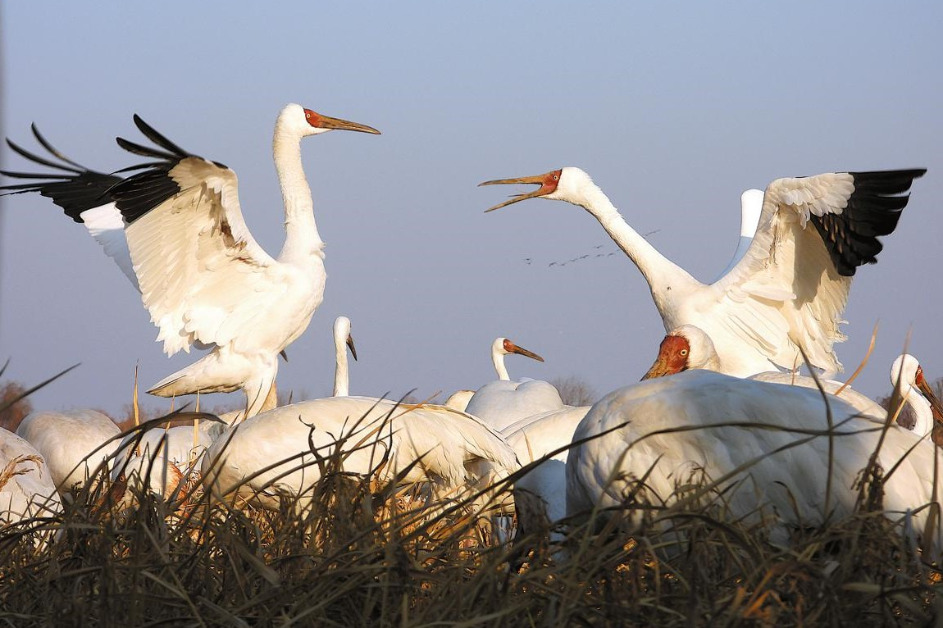Elegance in the air
Red-crowned crane

Editor's note: As protection of the planet's flora, fauna and resources becomes increasingly important, China Daily is publishing a series of stories to illustrate the country's commitment to safeguarding the natural world.

The Zhalong National Nature Reserve in Heilongjiang province has released over 380 red-crowned cranes into the wild, making it the world's largest and most populous breeding and habitat site for wild red-crowned cranes, as well as being a base for artificial breeding and rewilding.
Established in 1979, the reserve was upgraded to a national-level reserve by the State Council in 1987 and is now known as the hometown of red-crowned cranes.
It was inscribed on the List of Wetlands of International Importance in 1992 and was honored as one of China's Top Ten Charming Wetlands in 2013.
Reflecting on these hard-won achievements, Wang Wenfeng, a conservationist who has worked at the reserve for 21 years, has many emotions.
When he began his work at Zhalong, Wang initiated the establishment of a red-crowned crane captive breeding work group and set up a red-crowned crane captive breeding base. The work aimed to reduce interference in the breeding of free-range red-crowned cranes and facilitate the successful rewilding of their offspring. This resulted in a new field of red-crowned crane captive breeding.
"The breeding season for red-crowned cranes is from March to June, with each pair laying one to two eggs at a time," said Wang. "Initially, we retrieved the eggs of free-range cranes for artificial incubation, but we gradually found that red-crowned cranes are often affected by environmental factors and predators, making it difficult to ensure the survival rate.
"Especially after May and June, flying insects and biting pests abound, constantly disturbing the incubation process, significantly reducing the success rate of hatching," he added.
In 2005, Wang began exploring captive breeding, establishing lineages and combining free-range experience to develop a systematic rewilding training method.
Over the past 20 years, Wang's team has established 50 pairs of red-crowned crane captive breeding families, producing over 600 offspring, with an average of over 30 each year.
"In the breeding work of red-crowned cranes, we have always adhered to the principle of prioritizing protection and using artificial breeding as a supplement," he said. "We avoid excessive breeding and instead continuously provide red-crowned crane populations with the ability to survive in the wild through scientific means, ensuring the species will not go extinct."
During the first several years of the 21st century, the Zhalong wetlands experienced degradation due to climate-induced dry periods and three wildfires, resulting in a visible reduction in aquatic plants and animals such as algae, fish and shrimp.
Since 2001, the reserve has carried out emergency water replenishment missions. "By artificially diverting water from the Nenjiang River to Zhalong, we solved the urgent problem," said Wang.
In 2009, the Heilongjiang provincial government took the lead in establishing a long-term water replenishment mechanism for Zhalong.
Qiao Weijie, deputy director of the Qiqihar Forestry and Grassland Bureau, which oversees the wetland area, said, "After the implementation of long-term water replenishment, the natural condition and biodiversity of Zhalong Wetland have been greatly improved."
According to satellite monitoring data from the Heilongjiang Provincial Meteorological Bureau, the total vegetation production in the Zhalong Reserve doubled from 2000 to 2020.
The red-crowned crane is a vigilant bird that often chooses to nest and breed hidden in the reed beds in relatively shallow waters.
"The water surface cannot be too deep," said Wang. "It needs to be easy for them to wade in for feeding and the height of the reeds cannot be too low to avoid detection by predators.
"In 2017, we found a sharp decline in the wild red-crowned crane population in the core area of the Lindian Reed Breeding Field," he said. "It was mainly due to excessive reed harvesting, leaving the cranes with no place to nest and breed."
After contacting the local forestry department, they adopted a reed leasing approach and continued implementing wetland restoration projects to reserve reed belts.
They provided compensation to farmers to preserve reed and create suitable habitats for red-crowned cranes and other rare waterfowl.
So far, the compensation area for reed ponds in the core area managed by the Zhalong administration has reached 1,300 hectares, with an annual compensation amount of 2 million yuan.























